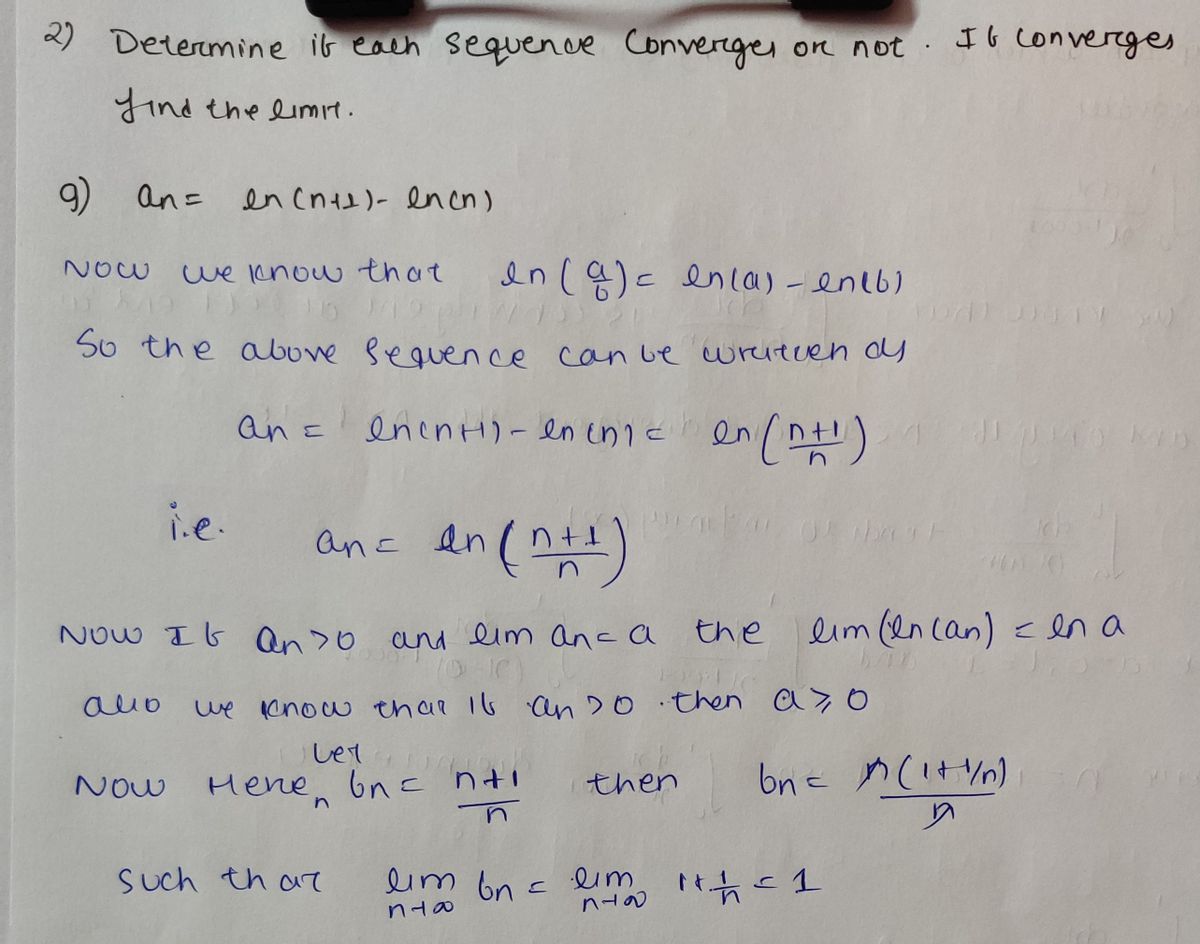Determine if each sequenceconverges or diverges. If it converges find the limit. Clearly explain your reasoning
Determine if each sequenceconverges or diverges. If it converges find the limit. Clearly explain your reasoning
Advanced Engineering Mathematics
10th Edition
ISBN:9780470458365
Author:Erwin Kreyszig
Publisher:Erwin Kreyszig
Chapter2: Second-order Linear Odes
Section: Chapter Questions
Problem 1RQ
Related questions
Topic Video
Question
2. Determine if each sequenceconverges or diverges. If it converges find the limit. Clearly explain your reasoning
![**Mathematical Sequences**
**g) Given Sequence:**
\[ a_n = \ln(n + 1) - \ln(n) \]
This sequence represents the difference between the natural logarithms of consecutive integers. The natural logarithm function, denoted by \(\ln\), is the inverse of the exponential function \(e^x\). This expression can also be rewritten using logarithmic properties as:
\[ a_n = \ln\left(\frac{n+1}{n}\right) \]
**h) Given Sequence:**
\[ a_n = \frac{(-3)^n}{n!} \]
This sequence involves the exponential term \((-3)^n\), where n is the term position, divided by the factorial of n, denoted by \(n!\). The factorial function \(n!\) is the product of all positive integers up to n. This expression describes a sequence that involves both exponential growth and factorial growth, which is useful in understanding series expansions like the Taylor series.](/v2/_next/image?url=https%3A%2F%2Fcontent.bartleby.com%2Fqna-images%2Fquestion%2Fae075851-124b-4baf-8c63-dff23bca9529%2F863e2bd4-d32a-4873-8876-84b7800dcfcb%2Fryeblb_processed.png&w=3840&q=75)
Transcribed Image Text:**Mathematical Sequences**
**g) Given Sequence:**
\[ a_n = \ln(n + 1) - \ln(n) \]
This sequence represents the difference between the natural logarithms of consecutive integers. The natural logarithm function, denoted by \(\ln\), is the inverse of the exponential function \(e^x\). This expression can also be rewritten using logarithmic properties as:
\[ a_n = \ln\left(\frac{n+1}{n}\right) \]
**h) Given Sequence:**
\[ a_n = \frac{(-3)^n}{n!} \]
This sequence involves the exponential term \((-3)^n\), where n is the term position, divided by the factorial of n, denoted by \(n!\). The factorial function \(n!\) is the product of all positive integers up to n. This expression describes a sequence that involves both exponential growth and factorial growth, which is useful in understanding series expansions like the Taylor series.
Expert Solution
Step 1

Step by step
Solved in 2 steps with 2 images

Knowledge Booster
Learn more about
Need a deep-dive on the concept behind this application? Look no further. Learn more about this topic, advanced-math and related others by exploring similar questions and additional content below.Recommended textbooks for you

Advanced Engineering Mathematics
Advanced Math
ISBN:
9780470458365
Author:
Erwin Kreyszig
Publisher:
Wiley, John & Sons, Incorporated

Numerical Methods for Engineers
Advanced Math
ISBN:
9780073397924
Author:
Steven C. Chapra Dr., Raymond P. Canale
Publisher:
McGraw-Hill Education

Introductory Mathematics for Engineering Applicat…
Advanced Math
ISBN:
9781118141809
Author:
Nathan Klingbeil
Publisher:
WILEY

Advanced Engineering Mathematics
Advanced Math
ISBN:
9780470458365
Author:
Erwin Kreyszig
Publisher:
Wiley, John & Sons, Incorporated

Numerical Methods for Engineers
Advanced Math
ISBN:
9780073397924
Author:
Steven C. Chapra Dr., Raymond P. Canale
Publisher:
McGraw-Hill Education

Introductory Mathematics for Engineering Applicat…
Advanced Math
ISBN:
9781118141809
Author:
Nathan Klingbeil
Publisher:
WILEY

Mathematics For Machine Technology
Advanced Math
ISBN:
9781337798310
Author:
Peterson, John.
Publisher:
Cengage Learning,

